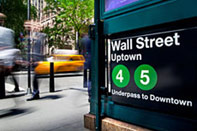Insider’s Guide to New York City Commuting

A path through the concrete jungle, New York is divided into five boroughs busting at the seams with art, architecture, culture, restaurants, bars, nightlife, museums, and local flair. Spread over eighty neighborhoods like the West Village, Nolita, Lower East Side, Chelsea, Flatiron, the Meat Packing District, Morningside Heights, and Harlem. Any New Yorker knows the people, and even some places, that fill the streets one day might be a distant memory the next. The city may constantly be changing, but regardless of what comes and goes there is one thing that never changes… a need to know how to commute in New York City.
Insider Tip One: Look Down and Invest in Comfort
The subways, buses, cabs, and railways are all at your disposal to transport you around the city. Regardless of which mode of transportation you choose, you’ll have to depend on your feet to get you there.
The New York City streets can be overwhelming and are filled with countless distractions. Before you leave your New York City apartment, strap on comfortable shoes, be bold, and plan a route. While mobile, do not expect anyone on the street to stop and give you directions. In New York people are friendly but discovering New York on your own is part of the adventure.
Insider Tip Two: It’s Not 1986
Before you venture out, make sure you are up-to-date with current technology. You don’t need to fill your pockets with tokens to make your way through the city; the MetroCard replaced tokens some time ago and is your ticket to ride subways, buses and other transit systems throughout the boroughs.
Now, it is time to be thankful for your cell phone because GPS and maps can be your best friend while traveling the many streets of the city. And, let’s face it… looking down at your cell phone is a lot more subtle than holding a large fold out paper map that is blowing in the wind as locals pass by and laugh. You can use your phone to check bus, railway and subway routes and even stops and delays.
Insider Tip Three: Yellow Means Slow Down
If you are about to jump into one of the thousands of cabs in New York, it is helpful to stop and really think about where you are heading. Most taxicabs start with a flag fare between $2.50-$3.50 depending on where you are going and what time of day it is and quickly tick up from there. A ‘typical’ taxi fare is not all you have to take into consideration, so make sure you are prepared and knowledgeable about both the place you are headed and from where you’re coming (for example, a $45 flat fare applies to travel from JFK airport). It would also be a good idea to familiarize yourself with the Taxicab Rider Bill of Rights – which is available in Spanish, Russian, and Chinese.
Also, keep in mind that passengers are responsible to pay for every toll they pass when in a cab. The cost of each toll will vary, but some can drastically change your total cab fare. In addition to tolls, be prepared for traffic and other factors that might drain more out of you and your wallet.